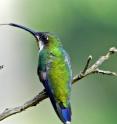New research shows that hummingbird tongue is really a tiny pump
In a paper titled Hummingbird tongues are elastic micropumps which appears in the August 19 issue of Proceedings of the Royal Society B, Alejandro Rico Guevara and Margaret Rubega from the Department of Ecology and Evolutionary Biology and Tai-Hsi Fan from the School of Engineering, say that fluid is actually drawn into the tongue by the elastic expansion of the tongues grooves after they are squeezed flat by the beak. Their data shows that fifty years of research describing how hummingbirds and floral nectar have coevolved will have to be reconsidered.
What is actually taking place, the researcher report, is that during the offloading of the nectar inside the bill, hummingbirds compress their tongues upon extrusion. The compressed tongue remains flattened until it contacts the nectar surface, after which the tongue reshapes, filling entirely with nectar.
The expansive filling mechanism uses the elastic recovery properties of the groove walls to load nectar on the tongue in an order of magnitude that allows the hummingbirds to extract nectar at higher rates than are predicted by capillarity-based foraging models.
Observations and measurements were taken from seven countries throughout the Americas where free-living, never handled hummingbirds were feeding at modified transparent feeders simulating nectar volumes and concentrations of hummingbird pollenated flowers. The researchers measured 96 foraging bouts of 32 focal birds belonging to 18 species from seven out the nine main hummingbird clads.
In the hundreds of licks studied, the researchers observed capillarity only once, acting on a single tongue groove. This occurred when, during initial tongue protrusion, one of the groove tips adhered to the feeder wall before the tip reached the surface of the nectar pool and the groove tip bent as the tongue continued to move forward.
Thanks to this unusual incident, high speed video captured one of the two grooves being filled by expansive filling, as usual, while the other was being filled by capillarity. This offered an opportunity to directly compare the two mechanism and measurements clearly demonstrated that the capillary filling rate was significantly slower than expansive filling.
Rico-Guevara says, "Our research shows how hummingbirds really drink and provides the first mathematical tools to accurately model their energy intake, which in turn informs our understanding of their foraging decisions and ecology."
Source: University of Connecticut
Other sources
- Hummingbird tongue is really a tiny pumpfrom Science DailyWed, 19 Aug 2015, 15:00:32 UTC
- Study: Hummingbirds' tongues act like micro pumpsfrom UPIWed, 19 Aug 2015, 14:30:14 UTC
- Hummingbird Tongues Are 'Micropumps' | High-Speed Videofrom Live ScienceWed, 19 Aug 2015, 12:00:15 UTC
- Photos: Hummingbirds Slurp Up Tasty Nectarfrom Live ScienceWed, 19 Aug 2015, 12:00:12 UTC
- Hummingbird tongues are tiny pumps that spring open to draw in nectarfrom PhysorgWed, 19 Aug 2015, 10:30:26 UTC
- Watch: Hummingbird tongues are tiny pumpsfrom Science NOWTue, 18 Aug 2015, 23:50:04 UTC
- Hummingbird tongues may work like micropumpsfrom Sciencenews.orgTue, 18 Aug 2015, 23:10:08 UTC
